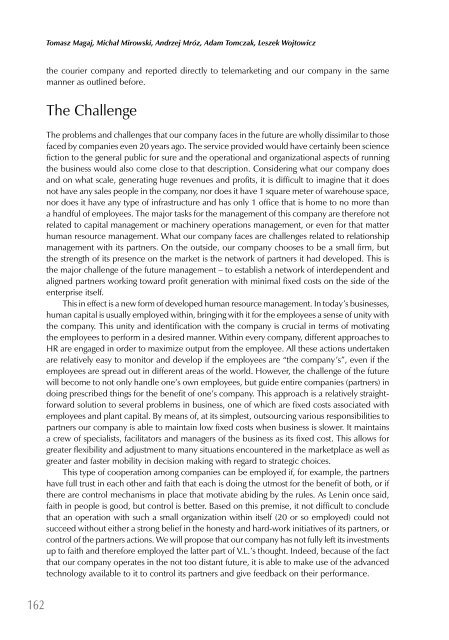Przerażony kameleon - eseje o przyszłości zarządzania - E-mentor
Przerażony kameleon - eseje o przyszłości zarządzania - E-mentor
Przerażony kameleon - eseje o przyszłości zarządzania - E-mentor
- TAGS
- kameleon
- eseje
- e-mentor.edu.pl
Create successful ePaper yourself
Turn your PDF publications into a flip-book with our unique Google optimized e-Paper software.
162<br />
Tomasz Magaj, Michał Mirowski, Andrzej Mróz, Adam Tomczak, Leszek Wojtowicz<br />
the courier company and reported directly to telemarketing and our company in the same<br />
manner as outlined before.<br />
The Challenge<br />
The problems and challenges that our company faces in the future are wholly dissimilar to those<br />
faced by companies even 20 years ago. The service provided would have certainly been science<br />
fiction to the general public for sure and the operational and organizational aspects of running<br />
the business would also come close to that description. Considering what our company does<br />
and on what scale, generating huge revenues and profits, it is difficult to imagine that it does<br />
not have any sales people in the company, nor does it have 1 square meter of warehouse space,<br />
nor does it have any type of infrastructure and has only 1 office that is home to no more than<br />
a handful of employees. The major tasks for the management of this company are therefore not<br />
related to capital management or machinery operations management, or even for that matter<br />
human resource management. What our company faces are challenges related to relationship<br />
management with its partners. On the outside, our company chooses to be a small firm, but<br />
the strength of its presence on the market is the network of partners it had developed. This is<br />
the major challenge of the future management – to establish a network of interdependent and<br />
aligned partners working toward profit generation with minimal fixed costs on the side of the<br />
enterprise itself.<br />
This in effect is a new form of developed human resource management. In today’s businesses,<br />
human capital is usually employed within, bringing with it for the employees a sense of unity with<br />
the company. This unity and identification with the company is crucial in terms of motivating<br />
the employees to perform in a desired manner. Within every company, different approaches to<br />
HR are engaged in order to maximize output from the employee. All these actions undertaken<br />
are relatively easy to monitor and develop if the employees are “the company’s”, even if the<br />
employees are spread out in different areas of the world. However, the challenge of the future<br />
will become to not only handle one’s own employees, but guide entire companies (partners) in<br />
doing prescribed things for the benefit of one’s company. This approach is a relatively straightforward<br />
solution to several problems in business, one of which are fixed costs associated with<br />
employees and plant capital. By means of, at its simplest, outsourcing various responsibilities to<br />
partners our company is able to maintain low fixed costs when business is slower. It maintains<br />
a crew of specialists, facilitators and managers of the business as its fixed cost. This allows for<br />
greater flexibility and adjustment to many situations encountered in the marketplace as well as<br />
greater and faster mobility in decision making with regard to strategic choices.<br />
This type of cooperation among companies can be employed if, for example, the partners<br />
have full trust in each other and faith that each is doing the utmost for the benefit of both, or if<br />
there are control mechanisms in place that motivate abiding by the rules. As Lenin once said,<br />
faith in people is good, but control is better. Based on this premise, it not difficult to conclude<br />
that an operation with such a small organization within itself (20 or so employed) could not<br />
succeed without either a strong belief in the honesty and hard-work initiatives of its partners, or<br />
control of the partners actions. We will propose that our company has not fully left its investments<br />
up to faith and therefore employed the latter part of V.L.’s thought. Indeed, because of the fact<br />
that our company operates in the not too distant future, it is able to make use of the advanced<br />
technology available to it to control its partners and give feedback on their performance.

















